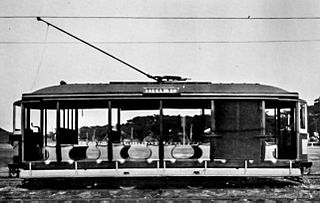
The Sydney tramway network served the inner suburbs of Sydney, Australia, from 1879 until 1961. In its heyday, it was the largest in Australia, the second largest in the Commonwealth of Nations, and one of the largest in the world. The network was heavily worked, with about 1,600 cars in service at any one time at its peak during the 1930s . Patronage peaked in 1945 at 405 million passenger journeys. Its maximum street trackage totalled 291 km in 1923.

The Brisbane tramway network served the city of Brisbane, Australia, between 1885 and 1969. It ran on standard gauge track. The electric system was originally energised to 500 volts, and subsequently increased to 600 volts. All tramcars built in Brisbane up to 1938 had an open design. This proved so popular, especially on hot summer nights, that the trams were used as fundraisers and often chartered right up until the last service by social groups.

Rozelle Tram Depot is a former tram storage and operations centre that was part of the Sydney tram network. It is the largest remaining former tram depot in Sydney. In 2016, the tram depot was redeveloped into a retail complex known as Tramsheds.

The O-class trams were a class of trams operated on the Sydney tram network.

The P-class trams were a class of trams operated on the Sydney tram network.

The R1-class trams were a class of trams operated on the Sydney tram network. Their design was a development of the R class.

The C-class trams were a class of single bogie end-loading electric trams operated on the Sydney tram network.

The D-class trams were a class of single bogie Californian Combination type trams operated on the Sydney tram network with open cross benches at the ends and a saloon in the centre.

The E-class trams were a class of single bogie (four-wheel) single-ended cross-bench design trams operated on the Sydney tram network. They always operated in permanently-coupled pairs because they were fitted-out electrically as if the pair was a single bogie car.

The F-class trams were a class of two-bogie California combination car trams operated on the Sydney tram network with longitudinal seating in the open part of the car. They were later rebuilt as the L-class trams and some again as the L/P-class trams.

The Sydney G-class Trams were a class of single ended cars were designed to operate either permanently coupled back to back in pairs or singly hauling a trailer on lines with reversing arrangements at the terminii.

The H-class trams were purpose built single truck, open cross bench cars built at Randwick Tramway Workshops as tourist cars for the City - Bondi Beach/Coogee and City - La Perouse/Botany services.

The J-class trams were built as replacements for the King Street to Ocean Street, Edgecliff cable line designed to provide a frequent schedule, but with a lower seating capacity. Some briefly operated on the Manly lines in 1911. Withdrawals commenced in 1934 with the entry of the R Class trams, with all out of service by 1936.

The K-class trams were a single truck all crossbench design, with closed compartments at one end and open seating at the other operated on the Sydney tram network. Withdrawals commenced in 1939. By 1949, only 1295 and 1296 remained in service on the Neutral Bay line, being withdrawn in the mid-1950s. Two were sold as track scrubbers in 1959 to Melbourne.

The M-class trams were built by the Randwick Tramway Workshops for use on tourist services on the Sydney tram network to replace two modified G class trams. Originally allocated to Fort Macquarie Tram Depot, they later moved to Newtown and again to Ultimo before being scrapped in 1941.

The N-class trams were a crossbench design of tram with a two-bogie design, each pair of benches had doors at each side.

Ridge Street Tram Depot was part of the Sydney tram network.
The N-class was a class of 10 trams built by Duncan & Fraser, Adelaide for the Hawthorn Tramways Trust (HTT) as numbers 11 to 20, all passed to the Melbourne & Metropolitan Tramways Board (M&MTB) on 2 February 1920 when it took over the HTT, becoming the N-class and being renumbered 117 to 126.

The P-class was a class of eight trams built by Duncan & Fraser, Adelaide for the Hawthorn Tramway Trust (HTT) as numbers 25 to 32. All passed to the Melbourne & Metropolitan Tramways Board on 2 February 1920 when it took over the HTT becoming the P-class and being renumbered 131 to 138.

Valley Heights Steam Tram Rolling Stock is a heritage-listed collection of tramway machinery at 17b Tusculum Road, Valley Heights, City of Blue Mountains, New South Wales, Australia. It was built from 1889 to 1891. The property is owned by Steam Tram and Railway Preservation (Co-op) Society. It was added to the New South Wales State Heritage Register on 21 October 2016.



















